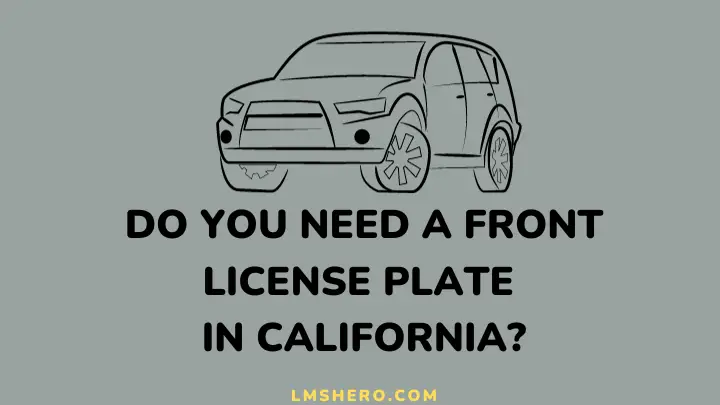In the bustling state of California, vehicles’ gleaming front or back license plate tells more than just a registration number. If you own a car, you probably know that you need to have a license plate on it. But do you know why?
License plates are not just decorative accessories but essential tools for identifying vehicles and ensuring public safety. They help law enforcement officers track down stolen cars, catch traffic violators, and enforce parking regulations.
They also help other drivers and pedestrians recognize your vehicle in case of an accident or emergency. But here’s the twist: Do you really need a front license plate in California? And what are the consequences if you don’t?
In this article, I will answer these questions and more as you explore the topic of front license plates in California. Whether you are a new or experienced driver, this article will help you understand the law and avoid any trouble on the road.
Do you need a front license plate in California?
California law mandates that vehicles must display both front and rear license plates. This regulation aims to enhance law enforcement’s ability to identify vehicles, maintain public safety, and prevent illegal activities. Here’s a detailed exploration of the nuances.
The legal landscape
As a vehicle owner in California, it is essential to understand the regulations outlined in the California Vehicle Code. Specifically, Section 5200 VC mandates that all vehicles must have two license plates – one attached to the front and one to the rear of the vehicle.
It is crucial to comply with this requirement, as failure to do so may result in fines. Therefore, it is highly recommended that vehicle owners adhere to this regulation to avoid any potential legal issues.
Penalties for non-compliance
The penalty for non-compliance with front vehicle plates in California can vary, and vehicle owners need to be aware of the potential consequences.
According to the California Vehicle Code, individuals who fail to comply with the regulations may be penalized up to $196, and court costs. It is also important to note that fines vary, and multiple offenses can escalate penalties.
The exact amount of the fine may depend on various factors, including the number of offenses and the discretion of law enforcement. It’s crucial to note that law enforcement in California takes front license plate regulations seriously.
Advantages of compliance with front license plate in California
As a vehicle owner in California, it may seem like a hassle to comply with the state’s requirement for front license plates. However, adhering to this regulation can provide significant benefits. Here are the advantages of compliance with front license plates in California.
1. Enhanced safety
Front license plates help law enforcement identify vehicles quickly and accurately, which can be crucial in emergency situations. It also helps reduce crime as it is easier to identify vehicles involved in illegal activities.
2. Avoiding fines
As I mentioned earlier, failure to comply with California’s front license plate regulation can result in fines. By adhering to this requirement, vehicle owners can avoid the cost and inconvenience of paying penalties.
3. Better resale value
A front license plate is essential for California vehicle owners who plan on selling their cars. Most buyers prefer vehicles compliant with state regulations, including front and rear license plates.
4. Insurance benefits
Some insurance companies offer discounts to vehicle owners who comply with California’s front license plate regulation. It’s always good to check with your insurance provider to see if you qualify for these discounts.
5. Simplified parking
Some parking garages and lots in California require vehicles to display front and rear license plates. Vehicle owners can avoid parking hassles and fines by complying with this requirement.
Addressing common concerns on front license plates in California

Do exemptions exist?
Exemptions for front license plates in California are limited and typically apply to specific vehicle types. While the general requirement is for vehicles to display both front and rear plates, certain categories are exempt from having a front license plate.
For example, motorcycles, Trailers, Tow dollies, and special equipment are commonly exempt from California’s front license plate rule.
However, vehicle owners need to check the California Vehicle Code for the most accurate and up-to-date information on exemptions, as regulations may change.
Understanding these exemptions is crucial for vehicle owners seeking clarity on whether their specific vehicle category is exempt from California’s front license plate requirement. Always refer to the latest legal guidelines to ensure accurate information and compliance with state regulations.
Impact on vehicle aesthetics
When it comes to installing license plates on a vehicle, many people worry about the negative impact on their car’s appearance. However, it’s important to remember that aftermarket license plate brackets and other creative solutions are available.
These can help ensure compliance with local laws without compromising the aesthetic appeal of your vehicle. From sleek and stylish brackets that blend in seamlessly with your car’s design, there are plenty of options to choose from.
You can also opt for specialized mounting systems that allow you to display your license plates in unique and eye-catching ways. By exploring these alternatives, you can find a solution that not only keeps you in compliance with the law.
It also lets you maintain the look and feel of your car that you love.
Enforcement discretion
When it comes to enforcement discretion, there are differing opinions on its validity and usefulness. However, depending on it entirely can be a risky move.
It’s important to note that strict adherence to rules and regulations remains the safest path to take, especially when considering the potential legal consequences that could arise from non-compliance.
By following the guidelines set forth by governing bodies, individuals and organizations can avoid unnecessary risks and ensure that they operate within the law’s bounds.
FAQs
Can you apply for an exemption for your vehicle?
Exemptions are limited and usually apply to specific vehicle types. Check the California Vehicle Code for eligibility.
What if your vehicle doesn’t have a designated front plate area?
Aftermarket solutions, like bumper-mounted brackets, can be explored. Ensure compliance without compromising your vehicle’s design.
Is law enforcement lenient about front license plate requirements?
In general, it depends on the specific law enforcement agency and the state in which you reside. Some states, like California, require vehicles always to have front license plates, while others may only require a rear license plate.
However, even in states requiring front license plates, law enforcement may be lenient and not strictly enforce this requirement. It’s always best to check with your local DMV or law enforcement agency to understand the specific requirements in your area.
Are there alternative ways to display the front plate without attaching it to the vehicle?
No, the California Vehicle Code explicitly requires attachment to the front of the vehicle.
What are the fines for non-compliance?
Individuals who fail to comply with the regulations may be penalized for up to $196, and court costs. It is also important to note that fines vary, and multiple offenses can escalate penalties.
Can you be pulled over solely for a missing front license plate?
Yes, law enforcement can stop a vehicle for not displaying front and rear license plates.
Conclusion
If you drive a passenger vehicle in California, you need a front license plate. This is the law, and driving without one can result in a ticket and a fine. However, there are some exceptions for certain types of vehicles, such as trailers, motorcycles, and commercial trucks.
If your vehicle doesn’t have space for a front plate, you have some options to avoid drilling holes in your bumper. You can use a magnetic mount, a manufacturer-recommended solution, or a vinyl sticker that replicates your license plate.
The latter is a new pilot program that allows you to ditch the bulky metal plate for a sleek wrap that sticks to your front fascia. Whether you choose to follow the law or find an alternative, you should be aware of the pros and cons of having a front license plate in California.
It may affect your vehicle’s performance, design, and safety, but also helps with identification, enforcement, and security. Ultimately, the decision is yours, but I hope this article has enlightened you about the need for license plates.
You can also find out who pays the president.
Thank you for reading.







